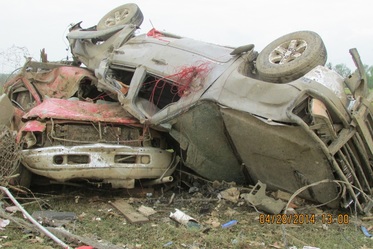|
Here are 5 simple steps you can take to start preparing your family for disasters. If you're just getting started, don't stress about doing everything right away. Take small steps toward your goals, and do what you can, when you can. 1) Determine What Types of Disasters Are Most Likely In Your Area
This is as easy as looking around and paying attention. Do you live in a flash-flood area? Is your home in Tornado Alley, U.S.A.? Are you near a major earthquake fault line? Maybe you live near an interstate or railroad line that might see a hazardous chemical spill in the wee-hours of the morning. Remember, disasters aren't always natural...some are man-made. Do a bit of research to see how often these disasters have hit your region in the past and prioritize your planning for the ones most likely to impact you. This helps you focus on what's most important, and save money and resources as you plan. 2) Once You've Identified Which Disasters You Need To Focus On, Learn More About Them There are plenty of resources available for disaster prepping, so learning more is easier than ever. And as you learn about "your" disasters, you'll begin to feel more confident about being able to prepare for, and survive, them. Each disaster brings unique challenges you'll need to meet...flash flooding requires evacuation, winter storms often require alternative electricity sources, tornadoes require quick and accessible shelter. Make a list of the unique challenges the disaster presents so you can focus your efforts. 3) Some Disaster Preparedness Items Are Universal - Stock Up There are some items that are needed for almost every disaster, so putting together a basic disaster kit is a good idea for every family. Humans need air, water, shelter, and food in every scenario. Learn how to put together a Bug-Out-Bag (BOB) that you can quickly grad in case of an emergency, whether you're evacuating or sheltering at home. There are tons and tons of recommendations on various web sites, so look around a little before you start shopping. And here's a tip: make copes of important papers like social security cards, insurance policies, and birth certificates, and ask a family member or friend you trust, who lives in another part of the U.S., to hold them for you. Then, if you have to evacuate quickly, or your home is destroyed by wildfires or floods, you can start to rebuild your life. 4) Develop A Communication Plan With Your Family We see it on the news all the time...a community is hit by disaster and loved ones are separated and don't know how to reach each other. Cell towers go down, the internet doesn't work, and basic infrastructures are destroyed, so you can't rely on cell phones and social media in every case. Make sure your household family members know where to meet up if you're all forced to evacuate, but you're not traveling together when you leave your home. Write down family members' phone numbers and put them in your BOB. Then, if your cell battery dies or you loose your phone, you'll still have important contact information. And share your evacuation and meet-up plans with relatives, too. Then they'll know where to start looking for you if they see on TV that your town's been hit by something catastrophic. 5) Practice Your Plans And Learn How To Use Your Supplies Don't wait until disaster strikes to try your disaster plan for the first time. And, if you've bought equipment, get familiar with how it works BEFORE you need to rely on it! As you practice, you'll figure out things you've forgotten and also get used to the idea of how your disaster response works. If you have a storm shelter, like a Safe Shed, spend a few hours in it to see what you need to add to make it more comfortable. Announce a drill to your family, throw the Bug-Out-Bag in the trunk, and head out of town. Then stop and open your bag to see what supplies you have to use to survive. Having a few dry runs under your belt will help everyone in the family be more confident and comfortable when the worst happens.
0 Comments
A Safe Sheds above ground storm shelter isn't just poured concrete. There's steel rebar reinforcement throughout the shelter to ensure life-saving strength. As you can see in the photos above, an entire rebar cage is constructed before the interior concrete forms are put in place. And a rebar grid will also be attached to the wall grid rebar and assembled for the roof of the shelter.
This design meets FEMA 320 and 361 standards for safe rooms that provide near-perfect protection in the face of EF5 tornadoes and Cat 4 hurricanes. If you want to learn more about FEMA specifications and requirements, we'd be happy to e-mail you a free copy of FEMA Publication 320, "Surviving The Storm". |
AuthorMembers of the Safe Sheds team contribute posts from time-to-time. Archives
November 2017
Categories |
We always welcome your visit
1003 South Maple Street
Salem, Illinois 62881 Monday - Friday, 8:00 a.m. - 4:30 p.m. CST 888-556-1531 (toll free) 618-740-0044 (local) [email protected] |
Contact UsSubscribe |


 RSS Feed
RSS Feed
